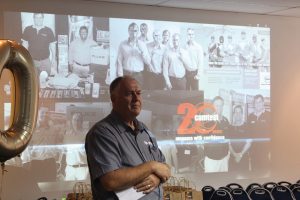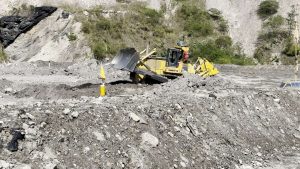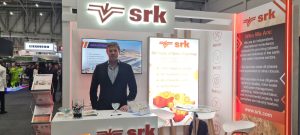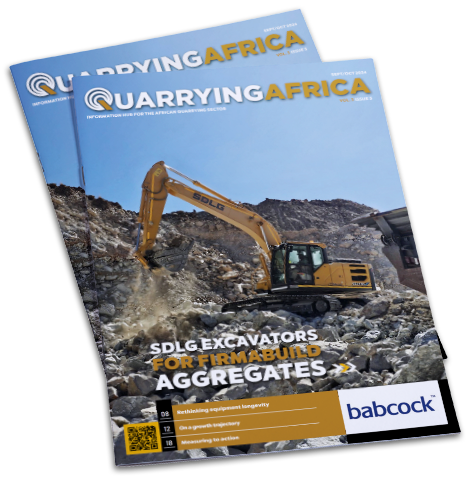Leading HVAC specialist Booyco Engineering used Electra Mining Africa in September this year to unveil its groundbreaking diesel-saving innovation to the mining and quarrying industry. The APU is basically a small generator that is designed to run an HVAC system of a mining machine such as a dump truck, excavator or wheel loader, while the main engine of that particular machine is switched off.
Brenton Spies, MD of Booyco Engineering, tells Quarrying Africa that this is particularly helpful in situations where mining machines have to stand for long periods, for example, while waiting to load or to be loaded. Traditionally, he says, switching off the machine during such periods was standard procedure. However, on the back of new health and safety laws, this is no longer possible.
With heat and body stress defined as a Category A safety hazard, it is therefore mandatory – as long as the operator is inside the cab – for HVAC systems to be kept running at all times, even when the machine is not productive. In fact, heavy machine operators are now even entitled to stop work if the HVAC system is not functioning properly. This is in direct contrast to 15 years ago when operators would just work with an open window if the HVAC system stopped working for any reason, exposing the operator to potentially hazardous dust and silica particles.
“Based on our understanding of the challenges in the mining sector, we realised that there was a gap in the market for a unit that could keep not only the HVAC running, but also other related systems such as filtration systems, communication systems and proximity detection systems, while the main diesel engine of the machine is off,” says Spies. “This led to the design of the APU, which we believe is a groundbreaking advancement for the mining industry, enabling operations to enhance efficiency, reduce operating costs and meet carbon emission targets, whilst ensuring operator safety and comfort at all times.”

Unit in detail
On most mining machinery, the APU is mounted on the back of the cab. The 24-VDC air conditioning system used in mining trucks and other equipment integrates seamlessly with APU. The HVAC unit is T3-rated and is suitable for operation in ambient temperatures up to 46°C. The APU can be connected directly to the main diesel tank of the piece of equipment. With minimal piping and wiring, connecting the unit is quick and easy.
“The APU is a culmination of Booyco Engineering’s 40 years of experience as an HVAC service provider to mines and quarries. We have cut our teeth across a number of demanding sectors, designing, manufacturing and maintaining HVAC systems for customers in the railway, defence and mining industries. We are therefore used to designing HVAC systems to a very high specification in order to ensure they survive the high vibration, dust and extreme temperature environments they are expected to operate in. We have taken that experience and applied it to the APU and our standard HVAC range,” says Spies.

Key benefits
The big benefit of the APU is the diesel saving that comes with the ability to power the HVAC system with a much smaller engine compared to that of the mining truck, for example. Given that transportation, on average, accounts for a large portion of the total mining costs at most opencast operations, deploying the APU will result in significant cost savings for the mine or quarry.
“In high ambient temperatures prevalent on southern African and for that matter most mines worldwide, truck operators often keep the main engine running to maintain a comfortable cab temperature while waiting to be loaded. While this is understandable in terms of health and safety, this practice can be costly – the truck can consume large volumes of diesel per hour through idling,” says Spies.
For example, a typical 100-tonne (t) truck runs with a 21-litre engine, which consumes between 37,5 and 94 litres of diesel per hour, depending on duty cycle. In low-duty cycles, such a truck can consume between 37,5 and 56,3 litres of diesel per hour. In contrast, the APU only consumes, at most, 1,5 litres of diesel per hour.
Significantly, the cost of the APU is offset by its relatively short payback period, thanks to its low running costs. While the payback period varies depending on the mine and each vehicle’s standing periods, Spies reckons that the payback period for the APU will be, on average, between six to 12 months.
In addition, a significant reduction in fuel consumption translates into reduced carbon emissions. This is particularly important for Environmental, Social and Governance- (ESG-) focused mining companies that seek to build strong relationships with communities, regulators, employees, customers and suppliers. ESG has now become such a critical component of any mining company’s strategy in the face of the green revolution.
“The APU is a valuable asset in hot climates such as those found across many mining destinations in Africa. A typical yellow metal hauler’s cabin is tantamount to a glass box. If, for example, one is operating in hot climates of about 40°C without any ventilation, temperatures in the cabin can rise to as high as 65-70°C in as little as 30 minutes, which is life-threatening. It is therefore important to ensure that HVAC systems are running at all times,” says Spies.

Support matters
Although the APU, just like Booyco Engineering’s HVAC systems, is designed to withstand tough operating conditions, Spies reiterates the need for regular maintenance to ensure that the unit operates at optimal performance rates at all times.
Booyco Engineering has been supplying and maintaining HVAC systems in mining for more than 35 years, during which time it has been offering its man-on-site service. The company still has units operating in these harsh conditions even after two decades, owing to the ruggedness and fit-for-purpose design of the units, as well as the complementary maintenance regime.
“If a mine or quarry buys HVAC systems from us and also signs up for a man-on-site contract, we offer a five-year warranty. That is how much trust we have in our design and manufacturing capabilities. However, it is obviously not just about buying a quality product, but also about maintaining it,” concludes Spies.







